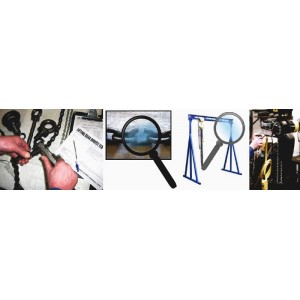
A thorough examination & inspection of lifting equipment is an essential part of any business that uses any form of lifting gear, large or small, from cranes and hoists to slings and shackles, they all need regular inspection by law to ensure all safety standards are met.
When using any type of equipment for handling, lifting or lowering goods and materials, the equipment must be safe in order to prevent any significant or even fatal injuries and damages to goods.
Every so often, lifting gear will require a lifting equipment inspection in compliance with Lifting Operations and Lifting Equipment Regulations 1998. These regulations ensure that lifting equipment is examined thoroughly to test that they are safe for physical use and that they are regularly checked and maintained as necessary to keep it safe.
In this blog, we take a look at the thorough examination and inspection of lifting equipment, how often this should be carried out and how to ensure that your lifting equipment is always safe for working use.
Lifting equipment inspections are necessary to ensure that lifting equipment can continue to be safely used by an operator.
Unfortunately, equipment is naturally going to degrade in quality over time and can become worn due to abrasion, corrosion or regular usage. Whilst our lifting equipment is designed to be long-lasting, no equipment can last forever and will need to be maintained and regularly inspected to ensure it is safe for use. Lifting gear inspections help to ensure that any light damages are spotted as soon as they arise, and can be resolved before they become a serious problem.
Not only do equipment inspections provide reassurance that lifting equipment is safe for use, but it’s also a legal requirement, so shouldn’t be compromised. Health and safety regulations, such as the LOLER (Lifting Operations and Lifting Equipment Regulations) place a number of obligations on workers controlling and using lifting equipment to ensure that all risks are minimised and that the equipment is safely used. The Provision and Use of Work Equipment Regulations 1998 (PUWER) also fall under the Health and Safety at Work Act 1974, meaning that inspections should not be missed and are compulsory.
Employers have the responsibility to ensure that lifting equipment is thoroughly examined and is always safe for use, by having a thorough examination and inspection at specific intervals and daily pre-use checks.
Lifting equipment inspections must include all matters which could affect the safety of the lifting equipment, such as damages or deterioration which has taken place over time.
This inspection is likely to include a visual examination, functional checks, measurements of wear, non-destructive load testing, some disassembly and sometimes an internal examination of parts.
Before the inspection has taken place, an examination scheme must be drawn up which outlines the plan for the inspection and includes information such as the parts to be examined, the intervals for examining or important inspection regimes. This must be produced as a written or printed copy which can be provided at any time if the relevant enforcing authority requests it.
Lifting equipment inspections should be carried out every six months or every 12 months for lifting items that are covered by PUWER, depending on the type of equipment that you have. However, pre-use checks must be made on a daily (or regular basis) whilst the more stringent checks are on an annual or bi-annual basis.
According to LOLER there are 2 main areas for inspections, Lifting equipment refers to the items that actually do the lifting like a gantry crane or lifting hoist, these need yearly inspections. Lifting accessories refers to items that are used to aid the lift, hold the load or make connections, things like lifting slings and shackles are included in this section, these need 6 monthly inspections.
LOLER states that you must ensure the equipment is; 1, safe to use 2, used correctly and safely, 3, continuously remains safe to use i.e. through inspections.
It’s worth noting that all lifting equipment will require a different frequency of inspection intervals, so a competent person could determine if it will require more or less frequently than you may expect.
According to the Lifting Operations and Lifting Equipment Regulations, a competent person must be anyone who has an appropriate practical and theoretical knowledge of lifting equipment and is able to detect any defects, damages or weaknesses in the lifting equipment, providing that the competent person is independent and impartial to ensure that the inspection or examination isn’t made in favour.
Based on any finds, the competent person must be able to decide whether or not the lifting equipment remains safe to use.
If you would like to know more about lifting gear inspections or would like to find out how to give your lifting gear a longer service life, please do not hesitate to get in touch with us.
At Lifting Gear Direct, we have almost 20 years’ experience in providing premium quality lifting gear and lifting equipment that is suitable for all professional applications. We offer expert advice and equipment at the best prices, delivered nationwide throughout the UK.
Speak to our team by calling 01384 76961 or fill in our contact form to discuss your requirements today.